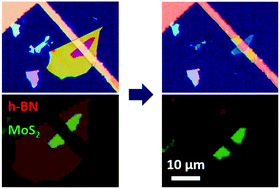Atomic-scale etching of hexagonal boron nitride for device integration based on two-dimensional materials†
Abstract
Hexagonal boron nitride (h-BN) is considered an ideal template for electronics based on two-dimensional (2D) materials, owing to its unique properties as a dielectric film. Most studies involving h-BN and its application to electronics have focused on its synthesis using techniques such as chemical vapor deposition, the electrical analysis of its surface state, and the evaluation of its performance. Meanwhile, processing techniques including etching methods have not been widely studied despite their necessity for device fabrication processes. In this study, we propose the atomic-scale etching of h-BN for integration into devices based on 2D materials, using Ar plasma at room temperature. A controllable etching rate, less than 1 nm min−1, was achieved and the low reactivity of the Ar plasma enabled the atomic-scale etching of h-BN down to a monolayer in this top-down approach. Based on the h-BN etching technique for achieving electrical contact with the underlying molybdenum disulfide (MoS2) layer of an h-BN/MoS2 heterostructure, a top-gate MoS2 field-effect transistor (FET) with h-BN gate dielectric was fabricated and characterized by high electrical performance based on the on/off current ratio and carrier mobility.



 Please wait while we load your content...
Please wait while we load your content...